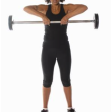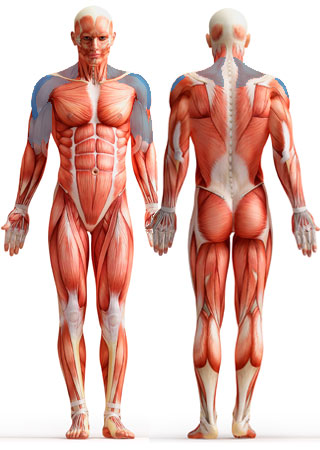Analysis by Dr Paul Batman
Exercise: Upright Row
Clients Instruction
Starting Position
 Stand in an upright position with your back straight
Stand in an upright position with your back straight- Hold a barbell in a pronated grip and hands a “two thumb” distance apart
- Contract your abdominals and spinal muscles to protect your low back
- Slightly bend your knees with the barbell resting on your thighs
Up Phase
 Begin the exercise by bending your elbows and lifting your arms to the side of your body
Begin the exercise by bending your elbows and lifting your arms to the side of your body- Keep the bar close to your chest at all times
- Raise the bar to you’re your chin and pause
- At the end of the movement the bar should be below your lower jaw
Down Phase
- Pause and then lower the bar down slowly back to the starting position
- Your elbows should be almost fully extended at the end of the movement
Muscle Analysis
Up Phase
Joint Action Contraction Muscle Group
Shoulder Joint Abduction Concentric Shoulder Joint Abductors
Elbow Joint Flexion Concentric Elbow Joint Flexors
Down Phase
In the down phase of the exercise the weight is lowered slowly with gravity. The same muscles that concentrically contracted to lift the weight are the same ones that are eccentrically contracting to lower the weight.
 General Kinesiological Analysis
General Kinesiological Analysis
In the upright row the shoulder joint is abducted by the contraction of the supraspinatus and the deltoid. The scapula movements of abduction and upward rotation are caused by the concentric contraction of the serratus anterior, pectoralis minor and the trapezius.
The elbow joint flexion is caused by the concentric contraction of the biceps brachii, brachialis, brachioradialis and the pronator teres.
Advanced Kinesiological Analysis
The prime movers of the shoulder joint in abduction are the supraspinatus and the deltoid. As the shoulder joint is initially medially rotated prior to abduction, the posterior deltoid is said to be main deltoid contributor. The prime movers of the scapula movements are the pectoralis minor, serratus anterior and the trapezius. The line of pull of the supraspinatus is directly across the top of the shoulder joint. In this position the supraspinatus pulls the humerus into abduction without an additional secondary action. While the posterior deltoid is shown to contribute more to the abduction of the humerus in a medially rotated position, any unwanted secondary movements are countered by the anterior and middle deltoid contractions.
The elbow joint is flexed by the concentric contraction of the biceps brachii, brachialis, brachioradialis and the pronator teres. As these muscles contract in elbow joint flexion with a supinated grip, the biceps brachii and pronator teres negate the supination and pronation that each can cause as a secondary action.
In the initial movement of the scapula, the serratus anterior and pectoralis minor contract to cause abduction. For this to occur there must be a simultaneous neutralizing of their additional movements of upward and downward rotation. As the shoulder continues to abduct, the scapula must move into upward rotation caused by the concentric contraction of the serratus anterior and the trapezius. When both these muscles contract in unison to cause upward rotation, they neutralize the additional adduction and abduction that each will also cause.
As the shoulder joint begins to abduct to lift the weight, the trapezius, pectoralis minor and the rhomboids contract statically to stabilize the scapula to allow the supraspinatus and deltoid to contract from a firm base. Once the weight is lifted, the scapula begins the move into abduction by the concentric contraction of the serratus anterior and the pectoralis minor. At this time the degree of stabilization of the abdominals and the spinal extensors is increased.
If the bar is moved further away from the chest, the action of the shoulder joint changes to a modified flexion, recruiting the pectoralis major, anterior deltoid and the coracobrachialis.
